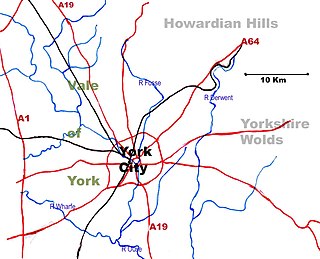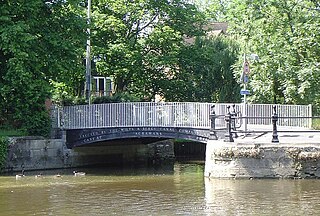
The Midvale Ridge is a natural region in South Central England formed by a band of low-lying limestone hills that run from southeast to northwest from the Vale of Aylesbury to Swindon. It has been designated as National Character Area 109 by Natural England, the UK Government's advisors on the natural environment.
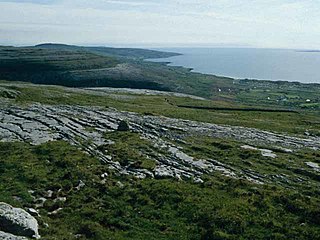
A natural region is a basic geographic unit. Usually it is a region which is distinguished by its common natural features of geography, geology, and climate.

Limestone is a carbonate sedimentary rock that is often composed of the skeletal fragments of marine organisms such as coral, foraminifera, and molluscs. Its major materials are the minerals calcite and aragonite, which are different crystal forms of calcium carbonate (CaCO3). A closely related rock is dolostone, which contains a high percentage of the mineral dolomite, CaMg(CO3)2. In fact, in old USGS publications, dolostone was referred to as magnesian limestone, a term now reserved for magnesium-deficient dolostones or magnesium-rich limestones.

Swindon is a large town in Wiltshire, South West England, between Bristol, 35 miles to the west, and Reading, the same distance to the east; the town is 71 miles (114 km) west of London. At the 2011 census, it had a population of 182,441. The Town Development Act 1952 led to a major increase in its population.
The Midvale Ridge crosses the counties of Wiltshire, Oxfordshire and Buckinghamshire. It is surrounded by the lowlands of the Oxfordshire clay vales and offers good views over the local countryside. The area is dominated by agriculture with a mixed arable/ pastoral farming landscape. Cereals are the most important arable crop. [1]

Wiltshire is a county in South West England with an area of 3,485 km2. It is landlocked and borders the counties of Dorset, Somerset, Hampshire, Gloucestershire, Oxfordshire and Berkshire. The county town was originally Wilton, after which the county is named, but Wiltshire Council is now based in the county town of Trowbridge.

Oxfordshire is a county in South East England. The ceremonial county borders Warwickshire to the north-west, Northamptonshire to the north-east, Buckinghamshire to the east, Berkshire to the south, Wiltshire to the south-west and Gloucestershire to the west.

Buckinghamshire, abbreviated Bucks, is a ceremonial county in South East England which borders Greater London to the south east, Berkshire to the south, Oxfordshire to the west, Northamptonshire to the north, Bedfordshire to the north east and Hertfordshire to the east.
The main settlements are the town of Swindon in the west, and the city of Oxford, in the centre. Otherwise the area is relatively sparsely populated with small nucleated villages along the crest of the ridge and along the springline. Soils comprise a mix of heavy rendzinas, stagnogleys and lighter sandy brown earths with small patches of sandy soils. [1]
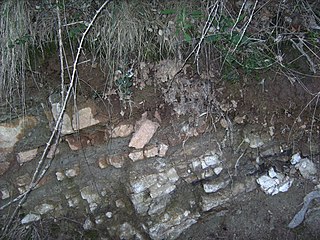
Rendzina is a soil type recognized in various soil classification systems, including those of Britain and Germany as well as some obsolete systems. They are humus-rich shallow soils that are usually formed from carbonate- or occasionally sulfate-rich parent material. Rendzina soils are often found in karst and mountainous regions.
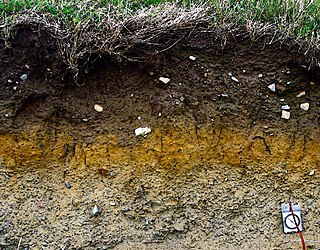
A stagnogley soil is a typically non-alluvial, non-calcareous, loamy or clayey soil with a relatively impervious, subsurface horizon. Stagnogley soils are related to the pseudogleys and are a type of gleyic soil. The name of this hygroscopic soil derives from its gley dynamics. The nutrient-poor, often heavily acidified soil is poorly aerated and is not suited to arable use on account of the poor growth performance of cultivated crops. As a shallow topsoil with a moderately stony subsoil, it is mainly used for woodland. Because of its shallow nature it is only suitable for species of trees that thrive well in these conditions, such as the English Oak.
The area has a number of important geological sites and has yielded fossils of international importance, including the holotypes for several ammonite species and several species of prehistoric sponges known only from the Faringdon area. [1]

A fossil is any preserved remains, impression, or trace of any once-living thing from a past geological age. Examples include bones, shells, exoskeletons, stone imprints of animals or microbes, objects preserved in amber, hair, petrified wood, oil, coal, and DNA remnants. The totality of fossils is known as the fossil record.

A holotype is a single physical example of an organism, known to have been used when the species was formally described. It is either the single such physical example or one of several such, but explicitly designated as the holotype. Under the International Code of Zoological Nomenclature (ICZN), a holotype is one of several kinds of name-bearing types. In the International Code of Nomenclature for algae, fungi, and plants (ICN) and ICZN the definitions of types are similar in intent but not identical in terminology or underlying concept.

Faringdon is a historic market town in the Vale of White Horse, Oxfordshire, England. Within the historic boundaries of Berkshire, it is 18 miles (29 km) southwest of Oxford, 10 miles (16 km) northwest of Wantage and 12 miles (19 km) east-northeast of Swindon. It is a large parish, its lowest parts extending to the River Thames in the north and its highest ground reaching the Ridgeway in the south.

